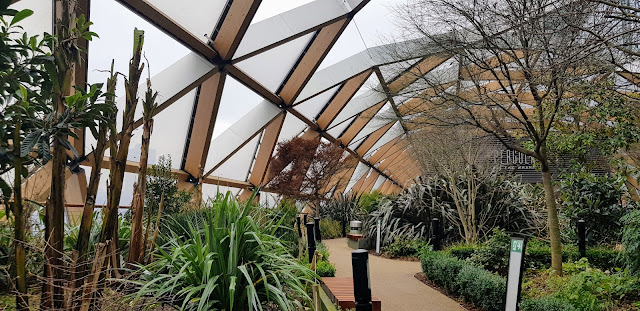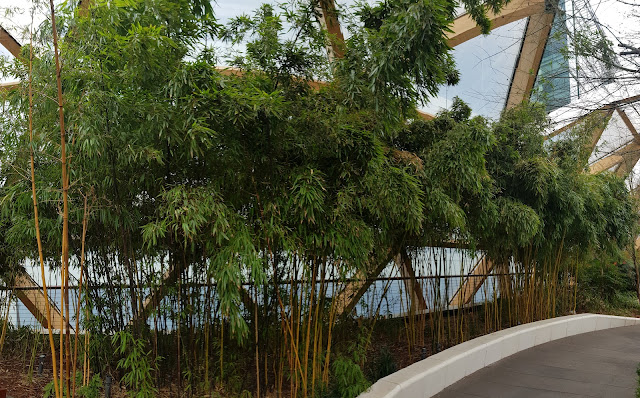 |
| View from the Roof Garden. |
One of the more interesting parts of the Canary Wharf development, for me, is the Crossrail Place Roof Garden.
From the outside it looks reminiscent of the Eden Project, in Cornwall, with huge plastic sheets, supported on the largest timber frame in the UK, covering much of the surface area. The rest is left open to the elements and acts like a giant terrarium.
 |
| Crossrail Place Roof Garden. |
Taking the escalator to the roof garden brings you out into a lush forest full of ferns, maples, strawberry and banana trees and much more.
 |
| Western ferns. |
Paths meander their way through this forest of two hemispheres with benches dotted sporadically around that allow you to sit and take in the fragrance and sounds of this hidden wonderland.
 |
| Looking east. |
Ferns, strawberry trees and banana trees soon give way to bamboos, magnolias and Japanese Maples as you cross the Prime Meridian from west to east.
 |
| Bamboo. |
You soon forget that you are in the shadow of the office buildings of Canary Wharf and are above the north dock, just a stones throw from Billingsgate Fish Market.
Brief History
Work began on the construction of Crossrail's Canary Wharf Station on May, 2009, with the Roof Garden opening in 2015.
It was designed to look like a ship laden with unusual and exotic specimens from around the globe, thereby keeping the history of the West India Docks alive.
The Ethylene Tetra Fluoro Ethylene encasing the roof garden has openings that allows natural light and natural irrigation, thus creating a microclimate that allows for rare plants to be planted.
The Crossrail Roof Garden lies almost directly on the Prime Meridian line, which inspired the distinct division, into two hemispheres, of the space itself.
 |
| One of the stylised benches in the roof garden. |
There are also information boards, along the various paths, that tell the history of the area, provide information on some of the plants and offer random pieces of trivia.
The roof garden also contains an 80 seat amphitheatre which offers free festivals, music and performances throughout the summer.
The roof garden is free and is open daily until 21:00, or sunset in the summer.
Interesting and informative. Although I've visited, I didn't know how it had come into being. Don't you just love London 😊
ReplyDeleteThank you for your comments. London is an ever changing and fascinating place that continues to intrigue me.
Delete